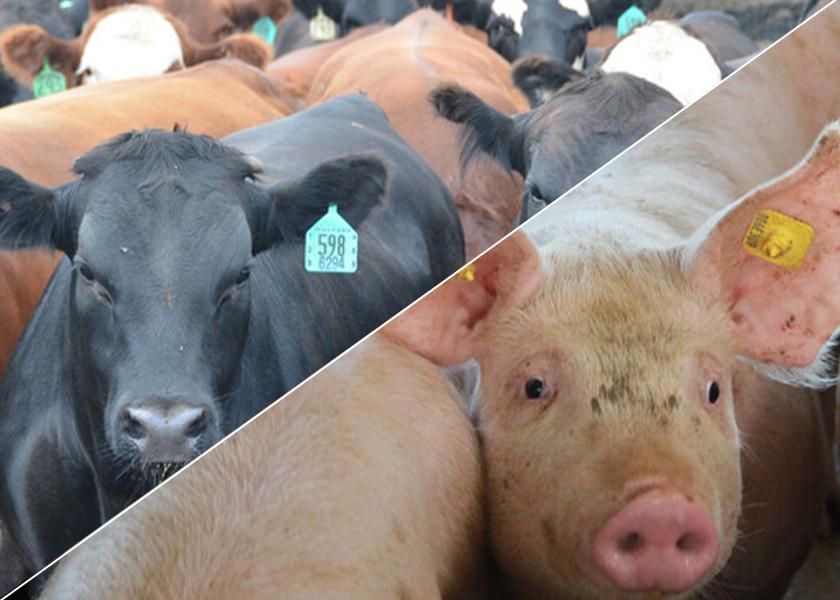Livestock Analysis | June 21, 2022

Price action: July lean hogs rose $1.725 to $112.725, the contract’s highest closing price since April 28. August hogs rose $1.925 at $109.80.
Fundamental analysis: Improving cash market fundamentals and a stronger near-term chart posture fueled gains in hog futures, sending nearby prices near a two-month closing high. The CME lean hog index rose 41 cents to $109.16, a 10-month high, and tomorrow’s quote is projected to gain another $1.29. The July contract is now trading premium to the CME cash hog index, with the August contract trading just slightly above it.
Pork cutout values early today fell $1.41 to $110.46, led by losses in bellies, though movement was decent at 164 loads. The national direct five-day rolling average cash hog price was quoted at $115.78 today. Solid gains in the U.S. stock market also emboldened buyers in hogs, as did a weaker U.S. dollar index.
Technical analysis: Hog futures bulls have a slight near-term technical advantage and are working on restarting price uptrends on the daily charts. The next upside objective for hog bulls is to close July prices above solid resistance at the June high of $114.00. The next downside objective for bears is closing prices below solid support at $100.00. First resistance is seen at today’s high of $112.65, then $114.00. First support is seen at today’s low of $110.50, then $109.00.
What to do: Be prepared to extend feed coverage on a pullback to the recent lows.
Hedgers: Carry all risk in the cash market for now.
Feed needs: You are hand-to-mouth on corn-for-feed and soybean meal needs.
Price action: June live cattle slipped 20 cents to $137.875, while August cattle fell 32.5 cents to $136.25. August feeder futures surged $2.35 to $175.30.
Fundamental analysis: Cattle traders appear to view last week’s Plains heat-driven cash strength as temporary, meaning cash prices may pull back substantially once supply disruptions fade. Much depends upon the speed with which the remaining cattle recover from the heat stress. It’s likely that animals, especially those closest to market weight, won’t recover that quickly, continuing to limit market-ready supplies available for packers. If so, cash prices could rise further, making the nearby contracts look that much more underpriced. Today’s nearby futures weakness obviously suggests that will not be the case, with the June and August slippage suggesting cash prices will give back a substantial portion of last week’s surge in the days just ahead.
Sharp losses in grain and soybean futures boosted feeder cattle, with traders thinking futures losses will translate into cheaper feed for feedlots, giving them increased incentive to spend on replacement yearlings. The feeder index resumed its recent surge last Friday, with the latest quote at $162.17 representing a jump of almost $8.00 since June 2. With nearby August trading at a significant discount to the deferred contracts, traders appear to expect a major price advance over the coming months. We harbor strong doubts on potential feeder strength, based upon skepticism of the large premiums built into deferred live cattle futures, although a sustained drop in corn and soybean meal prices would go far toward boosting feeder values.
Technical analysis: Bulls still hold a slight technical advantage in August live cattle. Despite today’s decline, bears couldn’t force a serious challenge of the contract’s 10-day moving average. Thus, initial support at today’s low of $135.975 is closely backed by the 10-day moving average at $135.89. Stronger backing is supplied by the 40-day moving average at $134.63 and the 20-day moving average at $134.32. A drop below those levels would open the door to a test of last week’s low at $132.45, then the pivotal $130.00 level. Today’s high placed initial resistance at $137.25, with additional resistance likely to emerge at the June 8 high at $137.95. A breakout above that point would have bulls targeting $140.00, then the contract high at $142.825.
Bulls hold a short-term advantage in August feeder futures, especially after the contract gapped above resistance at its 10-day moving average today. Today’s low places initial support at $174.15, with backing from the 10-day moving average at $173.41. Support at the conjunction of its 20- and 40-day moving averages near $171.00 looks formidable, so a drop below that level would probably develop momentum to test the June 1 low of $165.025, then the contract low at $162.80. Resistance at today’s high of $176.10 is closely backed by last week’s high at $176.875, with a breakout above that point likely having bulls targeting the psychological $180.00 level, then the March 29 high of $182.10.
What to do: Be prepared to extend feed coverage on a pullback to the recent lows.
Hedgers: Carry all risk in the cash market for now.
Feed needs: You are hand-to-mouth on corn-for-feed and soybean meal needs.






